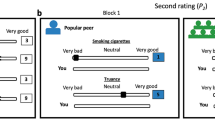Abstract
Existing measures of peer pressure and conformity may not be suitable for screening large numbers of adolescents efficiently, and few studies have differentiated peer pressure from theoretically related constructs, such as conformity or wanting to be popular. We developed and validated short measures of peer pressure, peer conformity, and popularity in a sample (n = 148) of adolescent boys and girls in grades 11 to 13. Results showed that all measures constructed for the study were internally consistent. Although all measures of peer pressure, conformity, and popularity were intercorrelated, peer pressure and peer conformity were stronger predictors of risk behaviors than measures assessing popularity, general conformity, or dysphoria. Despite a simplified scoring format, peer conformity vignettes were equal to if not better than the peer pressure measures in predicting risk behavior. Findings suggest that peer pressure and peer conformity are potentially greater risk factors than a need to be popular, and that both peer pressure and peer conformity can be measured with short scales suitable for large-scale testing.
Similar content being viewed by others
REFERENCES
Bauman, K. E., and Ennett, S. T. (1996). On the importance of peer influence for adolescent drug use: common neglected considerations. Addiction 91: 185–198.
Beck, A. T., Steer, R. A., and Garbin, M. G. (1988). Psychometric properties of the Beck Depression Inventory: Twenty-five years of evaluation. Clin. Psychol. Rev. 8: 77–100.
Brendt, T. J. (1979). Developmental changes in conformity to peers and parents. Develop. Psychol. 15: 606–616.
Brown, B. B. (1982). The extent and effects of peer pressure among high school students:Aretrospective analysis. J. Youth. Adolesc. 11: 121–133.
Brown, B. B., Clasen, D. R., and Eicher, S. E. (1986). Perceptions of peer pressure, peer conformity dispositions, and self-reported behavior among adolescents. J. Personal. Soc. Psychol. 22: 521–530.
Brown, B. B., Lohr, M. J., and McClenahan, E. L. (1986). Early adolescents' perceptions of peer pressure. J. Early Adolesc. 6: 139–154.
Clasen, D. R., and Brown, B. B. (1985). The multidimensionality of peer pressure in adolescence. J. Youth Adolesc. 14: 451–468.
Coleman, J., and Hendry, L. (1990). The Nature of Adolescence. Routledge, London and New York.
Corcoran, K., and Fisher, J. (1987). Measures for Clinical Practice: A Source Book. The Free Press, New York.
Dielman, T. E., Campanelli, P. C., Shope, J. T., and Butchart, A. T. (1987). Susceptibility to peer pressure, self-esteem and health locus of control as correlates of adolescent substance abuse. Health Educ. Quar. 14: 207–221.
Erikson, E. (1968). Identity, Youth and Crisis. Norton, New York.
Hartup, W.W. (1983). Peer relations. In Heatherington, E. M. (ed.), Mussen, P. H. (series ed.), Handbook of Child Psychology (Vol. 4): Socialization, Personality, and Social Development (pp. 103–196). Wiley, New York.
Hawkins, R. O., Jr. (1982). Adolescent alcohol abuse: A review. Develop. Behav. Pediatr. 3: 83–87.
Gold, M. (1970). Delinquency Behavior in an American City. Wadsworth, Belmont, CA.
Ide, J. K., Parkerson, J. A., Haertel, G. D., and Walberg, H. J. (1981). Peer group influence on educational outcomes: A quantitative analysis. J. Educ. Psychol. 73: 472–484.
Jensen, G. F., and Rojek, D. G. (1980). Delinquency: A Sociological View. Health, Lexington, MA.
Johnson, M. A. (1989). Concern for appropriateness scale and behavioral conformity. J. Personal. Assess. 53: 567–574.
Keena, K., Loeber, R., Zhang, Q., and Stouthamer, L. M. (1995). The influence of deviant peers on the development of boys' disruptive and delinquent behavior: A temporal analysis. Develop. Psychopath. 7: 715–726.
Newcomer, S. F., Urdy, J. R., and Cameron, F. (1983). Adolescent sexual behavior and popularity. Adolescence 18: 515–522.
Newman, P. R., and Newman, B. M. (1976). Early adolescence and its conflict: Group identity versus alienation. Adolescence 11: 261–274.
Robin, S. S., and Johnson, E. O. (1996). Attitude and peer cross pressure: Adolescent drug use and alcohol use. J. Drug Educ. 26: 69–99.
Santor, D. A., Ramsay, J. O., and Zuroff, D. C. (1994). Nonparametric item analyses of the Beck Depression Inventory. Examining item bias and response option weights in clinical and nonclinical samples. Psycholog. Assess. 6: 255–270.
Steinberg, L. (1987). Familial factors in delinquency: A developmental perspective. J. Adolesc. Res. 2: 255–268.
Steinberg, L., and Silverberg, S. B. (1986). The vicissitudes of autonomy in early adolescence. Child Develop. 57: 841–851.
Author information
Authors and Affiliations
Rights and permissions
About this article
Cite this article
Santor, D.A., Messervey, D. & Kusumakar, V. Measuring Peer Pressure, Popularity, and Conformity in Adolescent Boys and Girls: Predicting School Performance, Sexual Attitudes, and Substance Abuse. Journal of Youth and Adolescence 29, 163–182 (2000). https://doi.org/10.1023/A:1005152515264
Issue Date:
DOI: https://doi.org/10.1023/A:1005152515264




